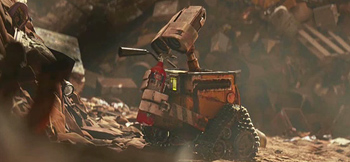In the Disney Pixar movie Wall-E, the three act structure is used in much the same way. The first act is where Wall-E (the main protagonist) is introduced. Without knowing much about him, the viewer follows him as he goes about his day, which prompts the question as to how his world came to look the way it is now. The tricky part about this movie following the three act structure, is that Wall-E doesn't speak a word until a second character comes into the story, making the question he is asking a little bit harder to discern.
The second point in the movie Wall-E is whenever he enters on the ship. While doing a bit of detective work, Wall-E discovers a video which shows him why his world is full of trash. Whenever trash became too large of a problem on Earth, many of the inhabitants were sent onto a ship for "just a few years" in order to clean up what they had left behind. The video later informs the protagonist that there was a problem with the clean-up effort and those living on the ship were never designed to return to Earth. The question Wall-E is now presented with is how he can work to fix what happened to his home planet.







